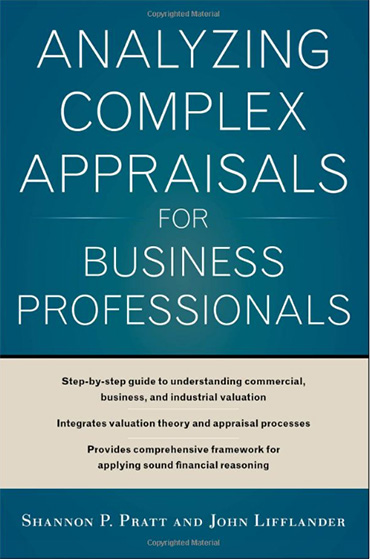Analyzing Complex Appraisals for Business Professionals
July 2016 978-0071812931 Hardcover (656 pages)
John Lifflander, Shannon Pratt
McGraw-Hill Co.
In Analyzing Complex Appraisals for Business Professionals, renowned business and real estate valuation authorities Shannon P. Pratt and John Lifflander provide the ultimate crash course for evaluating a wide range of properties and enterprises.
This guide to understanding, interpreting, and evaluating residential, commercial, business, and industrial appraisals, gives any business professional straightforward, practical steps to achieve sound financial reasoning in the face of numerous valuation intricacies and problem areas.
Using a similar approach to Pratt’s previous international bestselling books, the authors’ detailed instructions and invaluable insider advice make even the most sophisticated techniques accessible to bankers, attorneys, loan officers, accountants, real estate brokers, and other professionals. The authors introduce a strategic overview of the basics aspects of USPAP (Uniform Standards of Professional Appraisal Practice), and then build on that background. Each segment of the book includes a discussion of the applicable appraisal theory, which is then followed by an explanation of the most common methodologies for that particular discipline and a set of examples of its application. Analogies with general concepts are also applied to specific appraisal subjects.
The ability to evaluate a wide range of properties and enterprises from land and homes to commercial and industrial facilities to valuations of businesses is more imperative today than ever before. Find out why, and the best practices to do so, with Analyzing Complex Appraisals for Business Professionals.
Table of Contents
Section I: Real Estate and Machinery and Equipment Appraisals
Chapter 1: Introduction to Appraisal Theory and Terms
Chapter 2: Analyzing the Single-Family Residential Appraisal
Chapter 3: Analyzing the Land Appraisal
Chapter 4. Wetland, Contaminated Property, and Eminent Domain Land Appraisals
Chapter 5. Analyzing the Commercial Appraisal
Chapter 6. Commercial Appraisal Excerpts
Chapter 7. Analyzing the Industrial Building Appraisal
Chapter 8. Industrial Building Appraisal Excerpts
Chapter 9. Analyzing the Machinery and Equipment Appraisal
Chapter 10. Machinery and Equipment Appraisal Excerpts
Chapter 11. How Government Policies Can Affect Property Values
Chapter 12. USPAP: The Rules Under Which Appraisers Work
Section II. Business Valuations
Chapter 13. Defining Value in the Relevant Context: Definitions of Value
Chapter 14. Overview of Approaches, Methods, Procedures, and Terminology
Chapter 15. The Income Approach
Chapter 16. The Market Approach
Chapter 17. The Asset-Based Approach
Chapter 18. Rules of Thumb
Chapter 19. Valuations for Federal Tax Matters
Chapter 20. Shareholder and Partner Disputes
Chapter 21. Marital Dissolution Valuations
Chapter 22. Employee Stock Ownership Plans
Chapter 23. Analyzing the Business Appraisal: Example of an Appraisal of an Operating Company with Significant Real Assets
